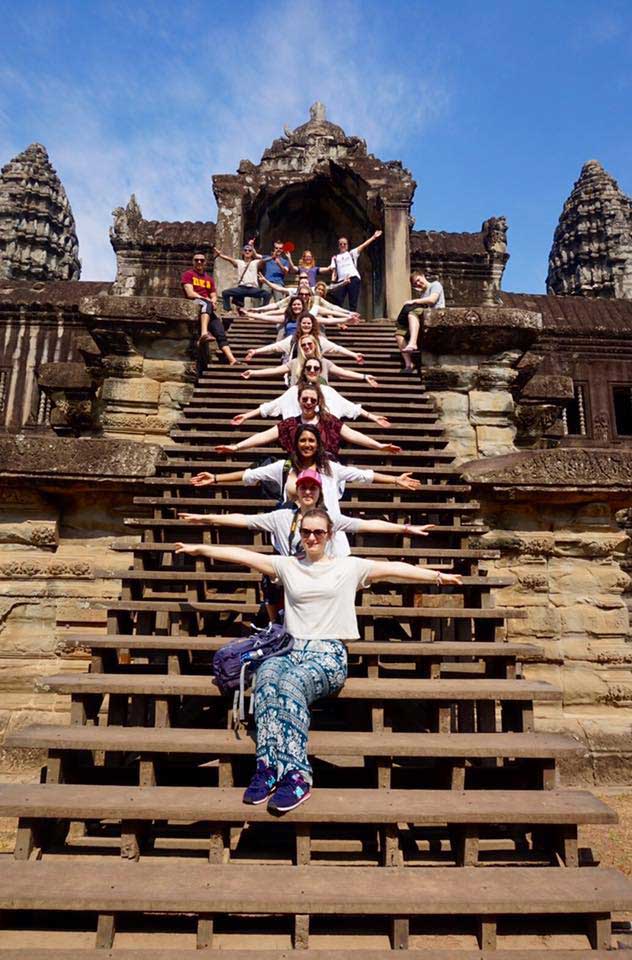Siem Reap province is located in northwest Cambodia. It is the major tourist hub in Cambodia, as it is the closest city to the world famous temples of Angkor (the Angkor temple complex is north of the city). The provincial capital is also called Siem Reap and is located in the South of the province on the shores of the Tonle Sap Lake, the greatest sweet water reserve in whole Southeast Asia. The name of the city literally means Siamese defeated, referring to the victory of the Khmer Empire over the army of the Thai kingdom in the 17th century.
At the turn of the millennium Siem Reap was a Cambodian provincial town with few facilities, minor surfaced roads and little in the way of nightlife. Tourism industry catered largely to hardy backpackers willing to brave the tortuous road from the Thai border on the tailgate of a local pick-up truck. There were a couple of large hotels and a handful of budget guesthouses. Tuk-tuks and taxis were non-existent and the trusty motodup was the chosen means of touring the temples of Angkor.
The proximity of the Angkorian ruins turned Siem Reap into a boomtown in less than half a decade. Huge, expensive hotels have sprung up everywhere and budget hotels have mushroomed. Property values have soared to European levels and tourism has become a vast, lucrative industry. The Siem Reap of today is barely recognizable from the Siem Reap of the year 2000.
Though some of the town’s previous ramshackle charm may have been lost the developments of the last few years have brought livelihoods, if not significant wealth, to a good number of its citizens. This has been at a cost to the underprivileged people living within and beyond the town’s limits that now pay inflated prices at the central markets and continue to survive on poorly paid subsistence farming and fishing. If Cambodia is a country of contrasts Siem Reap is the embodiment of those contrasts. Despite the massive shift in its economic fortunes, Siem Reap remains a safe, friendly and pleasant town. There is an endless choice of places to stay or dine and a host of possible activities awaiting the visitor.

Angkor wat
THINGS TO SEE & DO IN SIEM REAP:
Angkor Wat:
There are few places anywhere on earth to match the splendour of Angkor Wat. The temple is one of the largest monuments to religion ever built and is truly one the wonders of the world. Believed to have been constructed as a temple and mausoleum for King Suryavarman II at the peak of the Khmer empire in the first half of the 12th century, Angkor Wat is probably the best-preserved of the Angkorean temples. As with other Angkorean temples and walled cities such as Angkor Thom, the central theme of Khmer architecture revolved around the idea of the temple-mountain.
Angkor Zoo:
Angkor Zoo How to go: 5 km (10mn) From Provincial Town. Location: Description: Nature Wildlife and Preserves, Location: Mondol Chon Pika, Angkor Compound.The Angkor Zoo, Siem Reap is one of the most visited and popular tourist attractions in the town.
Banteay Srey Temple:
Location: 25 kilometers (15.5 miles) north-east of East Mebon
Access: enter and leave the temple by the east entrance
Date: second half of the 10th century (967)
King: Rajendravarman II (reigned 944-968) and Jayavarman V (reigned 968-1001)
Religion: Hindu (dedicated to Shiva)
The tenth century temple of Banteay Srei is renowned for its intricate decoration carved in pinkish sandstone that covers the walls like tapestry. This site warrants as much time as your schedule allows. The roads have been recently repaired and it takes about 30 minutes from Siem Reap to get to the temple.
Bakong Temple:
Bakong is located at Roluos south of Preah Ko. Enter and leave the temple at the east. A modern Buddhist temple is situated to the right of the east entrance to Bakong. It was build in late ninth century (881) by king Indravarman I dedicated to Siva (Hindu) followed Prah Ko art style.
Kompong Khleang:
Kampong Khleang is located on the northern lake-edge about 55 km east of Siem Reap town, more remote and less tourist than Kampong Pluk. Visitors to Kampong Khleang during the dry season are universally awestruck by the forest of stilted houses rising up to 10 meters in the air.
crocodile farm:
There is a crocodile farm on the south end of Siem Reap and they have about 300 crocodiles of various sizes and dispositions.They charge US$ 1 admission for foreigners and 1,000 riel for Cambodians. You can buy stuffed crocs on the premises. Just head south on Sivutha Street, cross the bridge and it’s down another km from there.
